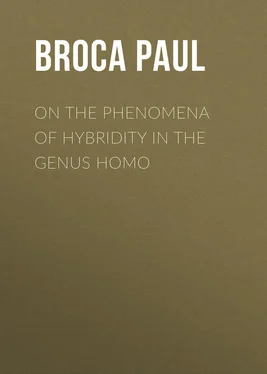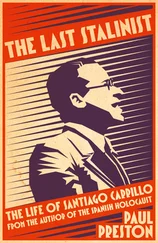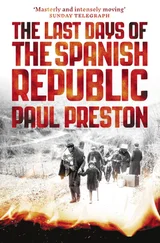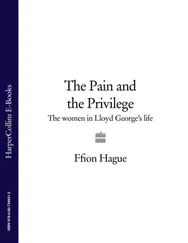Paul Broca - On the Phenomena of Hybridity in the Genus Homo
Здесь есть возможность читать онлайн «Paul Broca - On the Phenomena of Hybridity in the Genus Homo» — ознакомительный отрывок электронной книги совершенно бесплатно, а после прочтения отрывка купить полную версию. В некоторых случаях можно слушать аудио, скачать через торрент в формате fb2 и присутствует краткое содержание. Жанр: foreign_antique, foreign_prose, на английском языке. Описание произведения, (предисловие) а так же отзывы посетителей доступны на портале библиотеки ЛибКат.
- Название:On the Phenomena of Hybridity in the Genus Homo
- Автор:
- Жанр:
- Год:неизвестен
- ISBN:нет данных
- Рейтинг книги:4 / 5. Голосов: 1
-
Избранное:Добавить в избранное
- Отзывы:
-
Ваша оценка:
- 80
- 1
- 2
- 3
- 4
- 5
On the Phenomena of Hybridity in the Genus Homo: краткое содержание, описание и аннотация
Предлагаем к чтению аннотацию, описание, краткое содержание или предисловие (зависит от того, что написал сам автор книги «On the Phenomena of Hybridity in the Genus Homo»). Если вы не нашли необходимую информацию о книге — напишите в комментариях, мы постараемся отыскать её.
On the Phenomena of Hybridity in the Genus Homo — читать онлайн ознакомительный отрывок
Ниже представлен текст книги, разбитый по страницам. Система сохранения места последней прочитанной страницы, позволяет с удобством читать онлайн бесплатно книгу «On the Phenomena of Hybridity in the Genus Homo», без необходимости каждый раз заново искать на чём Вы остановились. Поставьте закладку, и сможете в любой момент перейти на страницу, на которой закончили чтение.
Интервал:
Закладка:
When we see the prosperity and the power of the new continent grow with such unexampled rapidity, we can certainly put no faith in such a prediction. Still there must have been a certain number of fundamental facts, which led even monogenists to deny the viability of all crossed races. They must have sought in vain among the nations of the earth for a race manifestly hybrid, with well-defined characters, intermediate between two known races, perpetuating itself without the concurrence of the parent races.
“When the facts quoted above,” says M. Georges Pouchet, “are not sufficient to prove that a mongrel breed cannot be engendered, can we anywhere find one? Do we find a people conserving a medium type between two other types? We see them nowhere just as little as we see a race of mules. The fact is, that such a race, such a type can only have an ephemeral subjective existence.” 3 3 Georges Pouchet, De la Pluralité des Races Humaines , p. 140, Paris, 1858. [A translation of this work will shortly be published by the Anthropological Society of London, edited by T. Bendyshe, Esq., M.A., F.A.S.L. Editor.]
Pretended examples of hybrid races (note on the Griquas of Southern Africa)
The question, where do we find hybrid races subsisting by themselves, has been asked before M. Pouchet. Dr. Prichard, in replying to it, could only find three instances: – 1. The Griquas, the progeny of the Hottentots and the Dutch. 2. The Cafusos of the forests of Varama (Brazil), a race described by Spix and Martius, and, according to them, the offspring of indigenous Americans and African Negroes. 3. The mop-headed Papuans inhabiting the island of Waigiou and the surrounding islands and the northern part of New Guinea, and who, according to MM. Quoy and Gaimard, are a hybrid race, the issue of a union of Malays and the Papuans proper. 4 4 Prichard, Natural History of Man .
These three examples have been objected to, and are indeed liable to objections. 5 5 Davis and Thurnam, Crania Britannica , p. 7, No. 4, London, 1856.
We know next to nothing about the Cafusos, and no one can positively assert that they have remained unmixed with the indigenous race; but we know for certain that the Griquas have risen since the commencement of this century around a Protestant mission, by the fusion of some Dutch-Hottentot bastaard families with a large number of the Hottentot race, the Bosjesmen, and the Kaffir race. This example then proves, by no means, that a mixed race can perpetuate itself separately. 6
With regard to the mop-headed Papuans, they live in a region the ethnography of which is scarcely known. MM. Quoy and Gaimard are of opinion that they are the issue of a mixture between the Malays and indigenous Negroes ( sic ); but they only advanced this opinion as an hypothesis: “They appeared to us to hold a medium place between those people (Malays) and the Negroes in regard to character, physiognomy, and the nature of their hair.” 7This is all those authors say; but Mr. Lesson instead of quoting this as a mere hypothesis, says, “These people have been perfectly described by MM. Quoy and Gaimard, who were the first to demonstrate that they constitute a hybrid race, and are, unquestionably , the issue of Papuans (properly so called) and Malays located in those parts, and which form the mass of the population.” Mr. de Rienzi, on the other hand, has described two varieties of Papuan hybrids: one variety the issue of a crossing between the Papuans and the Malays, – the Papou-Malays; the second variety, the issue of an intermixture between the Papuans and the Alforian-Endamenes – the Pou-Endamenes. 8There is already a complication here. Now comes Mr. Maury, who maintains that the race issued from the Papuans and Malays is the Alforian race. 9What are we to conclude from these contradictions? M. Quoy and Gaimard had a certain impression, M. Rienzi entertained a somewhat different impression, to which the authorities cited by Mr. Maury are altogether opposed. All is then, as yet, an hypothesis, and the question is as yet doubtful. In this uncertainty it might well be asked whether the Malays, the Alfourous, the mop-headed Papuans, and the Papuans properly so called might not be as many pure races. It is not merely in the region of the mop-headed Papuans that the other three races are to be met with. The Malays, an invading people par excellence , have, like the English, established themselves on all the coasts accessible to their vessels, and if the mop-headed race occupies only a very confined district, and is perfectly unknown elsewhere where the same elements are present, we are permitted to conclude that it is not the result of an intermixture. Moreover, Dr. Latham, the most zealous of Dr. Prichard’s pupils, informs us that Mr. Earle has seen and described “the real and undoubted hybrids” of the Papuans and Malays, and that these are altogether different from the mop-headed Papuans. 10
It will be perceived that the example of the Papuans is a worse selection than that of the Griquas, since it is very probable that those mop-headed men, the type of which was so perfectly described by Dampier two centuries ago, having been since preserved without alteration, are a pure race. Granting even that it is demonstrated that they belong to a hybrid race, they can scarcely be cited as a mixed race persisting by themselves, since, so far from living secluded from the two races from which they are said to be the issue, they live with them in the same localities. MM. Quoy and Gaimard, in their description of these pretended mongrels, add that there were Negroes among them (by which name they designate the Papuans proper) which formed a part of the tribe which visited us daily. There were even among them two individuals of a higher complexion, which, rightly or wrongly, were considered to be descended from Europeans or Chinese. It was thus a very mixed people. Mr. Lesson, speaking of the population of the small island of Waigiou, 11says that two races are found there, the Malays and the Alfourous, besides the hybrid races of the Papuans: “These are men without vigour or moral energy, subjected to the authority of the Malay rajahs, and frequently reduced to slavery by the surrounding islanders.” 12But it is well known what is the consequence of slavery, especially under an equatorial climate, and among a people given to incontinency. It is, then, simply impossible that the mop-headed race of the Isle of Waigiou should remain free from intermixture with the
Alfourous and the Malays, and if this race be really hybrid, it is not easy to see how Prichard and his adherents are authorised to assert that they persist by themselves.
The three examples adduced by Prichard having thus proved without any absolute value, a diametrically opposite doctrine has been advanced. It has been said that since this author was obliged to go so far for such indifferent examples, it amounts to a proof that he could not find any others, 13and the conclusion was arrived at that a mixed race neither has nor could have a permanent existence.
This novel assertion is perfectly erroneous, and if it found adherents, it is simply because the question has been badly put; because the word race has not received a precise signification, and consequently, a very confused acceptation has been given to the term.
Among the various characters which distinguish the numerous varieties of the genus homo , some are more or less important, and more or less evident. To distinguish two races, a single character, however slight, is sufficient, provided it be hereditary and sufficiently fixed. If, for instance, two peoples differed merely from each other by the colour of the hair and the beard, though they may resemble each other in every other respect, by the simple fact that the one has black, whilst the other has fair hair, it may be asserted that they are not of the same race. This is the popular and the true meaning of the term race, which, however, does not necessarily implicate the idea either of identity or diversity of origin. Thus all ethnologists and historians, all the monogenists, and polygenistic authors say that the Irish proper are not of the same race as the English. The Germans, the Celts, the Basques, the Sclaves, the Jews, Arabs, Kabyles, etc., etc., are considered more or less separate races, more or less easy to be characterised, and more or less distinguished by their manners, tongues, history and origin. There are thus a large number of human races; but if, instead of considering all the characters, we confine ourselves to take into consideration but a few of the more important, or if, after having by an analytical process, first studied the various races separately, we now subject them to a synthetic process, we soon recognise that there exists among them numerous affinities, which enable us to dispose them in a certain number of natural groups.
Читать дальшеИнтервал:
Закладка:
Похожие книги на «On the Phenomena of Hybridity in the Genus Homo»
Представляем Вашему вниманию похожие книги на «On the Phenomena of Hybridity in the Genus Homo» списком для выбора. Мы отобрали схожую по названию и смыслу литературу в надежде предоставить читателям больше вариантов отыскать новые, интересные, ещё непрочитанные произведения.
Обсуждение, отзывы о книге «On the Phenomena of Hybridity in the Genus Homo» и просто собственные мнения читателей. Оставьте ваши комментарии, напишите, что Вы думаете о произведении, его смысле или главных героях. Укажите что конкретно понравилось, а что нет, и почему Вы так считаете.












